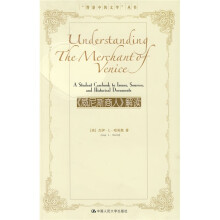Preface
Introduction
1. Literary and Dramatic Analysis
2. Venice and Its Treatment of Jews
FROM:
Laurence Alderseys Account of Venice (1581)
Thomas Coryat, Coryats Crudities (1611)
Fynes Moryson, An Itinerary (1617)
Fynes Moryson, Shakespeares Europe (1617)
William Thomas, The History of Italy (1549)
3. Attitudes Toward Jews
FROM:
Martin Luther, "Christ Was Born a Jew" (1523)
Richard Hooker, Of the Laws of Ecclesiastical Polity,Book 5 (1597)
An Enterlude of the Vertuous and Godly Queene
Hester (ca. 1522-27)
The Trial of Dr. Roderigo Lopez (1594)
William Camdens History of the Reign of Queen
Elizabeth (1607-17, 1625)
4. Classical and Renaissance Concepts of Male Friendship
FROM:
Cicero, De Amicitia (44 B.C.)
Sir Thomas Elyot, The Governor (1531)
Edmund Spenser, The Faerie Queene (1596)
Michel de Montaigne, "Of Friendship" (ca. 1580)
Sir Francis Bacon, "Of Friendship" (1625)
5. Elizabethan Marriage
FROM:
Heinrich Bullinger, The Christian State of
Matrimony (1541)
Edwin Sandys, Sermons (1585)
Henry Smith, A Preparative to Marriage (1591)
6. Usury, Interest, and the Rise of Capitalism
FROM:
The Geneva Bible (1560)
An Act against Usury (1571)
John Woolleys Speech in Parliament (1571)
Thomas Wilson, A Discourse upon Usury (1572)
John Calvin, Commentaries on the Last Books of
Moses (1554)
Yehiel Nissim da Pisa, The Eternal Life (1559)
Phillip Stubbes, The Anatomy of Abuses (1583)
7. Contemporary Applications and Interpretation
FROM:
Tom Tugend, "Synagogue arson suspects kept
hit-list of Sacramento-area Jews" (1999)
Bob Herbert, "Endless Poison" (1999)
A Letter by John Cardinal OConnor, Archbishop of
New York (1999)
A. Engler Anderson, "Male Bonding" (1994)
William Triplett, "The Shylock Within" (1999)
Index
《解读》introduces students to the many issues in the play with a Literary and Dramatic Analysis chapter. Six topic chapters examine the play in its historical context, combining expert discussion and primary documents, making this ideal for interdisciplinary study.The Merchant of Venice, even in its own time, was considered Shakespeare’s most controversial play. Now, one of the most popularly read and performed works, the play raises even more important issues for our day, particularly anti-Semitism and the treatment of Jews. Shakespeare scholar Jay Halio brings together his fascinating literary insights and his considerable knowledge of Shakespeare’s world to this student casebook. His analysis of the play helps students interpret Shakespeare’s plot and interwoven subplots, the sources that helped shape the play and the characters, and the thematic issues relating to justice, mercy and the myriad bonds of human relationships. This casebook also considers contemporary applications, with essays and editorials on current hate groups in the United States, the treatment of women, and male bonding.

 缺书网
缺书网 扫码进群
扫码进群





